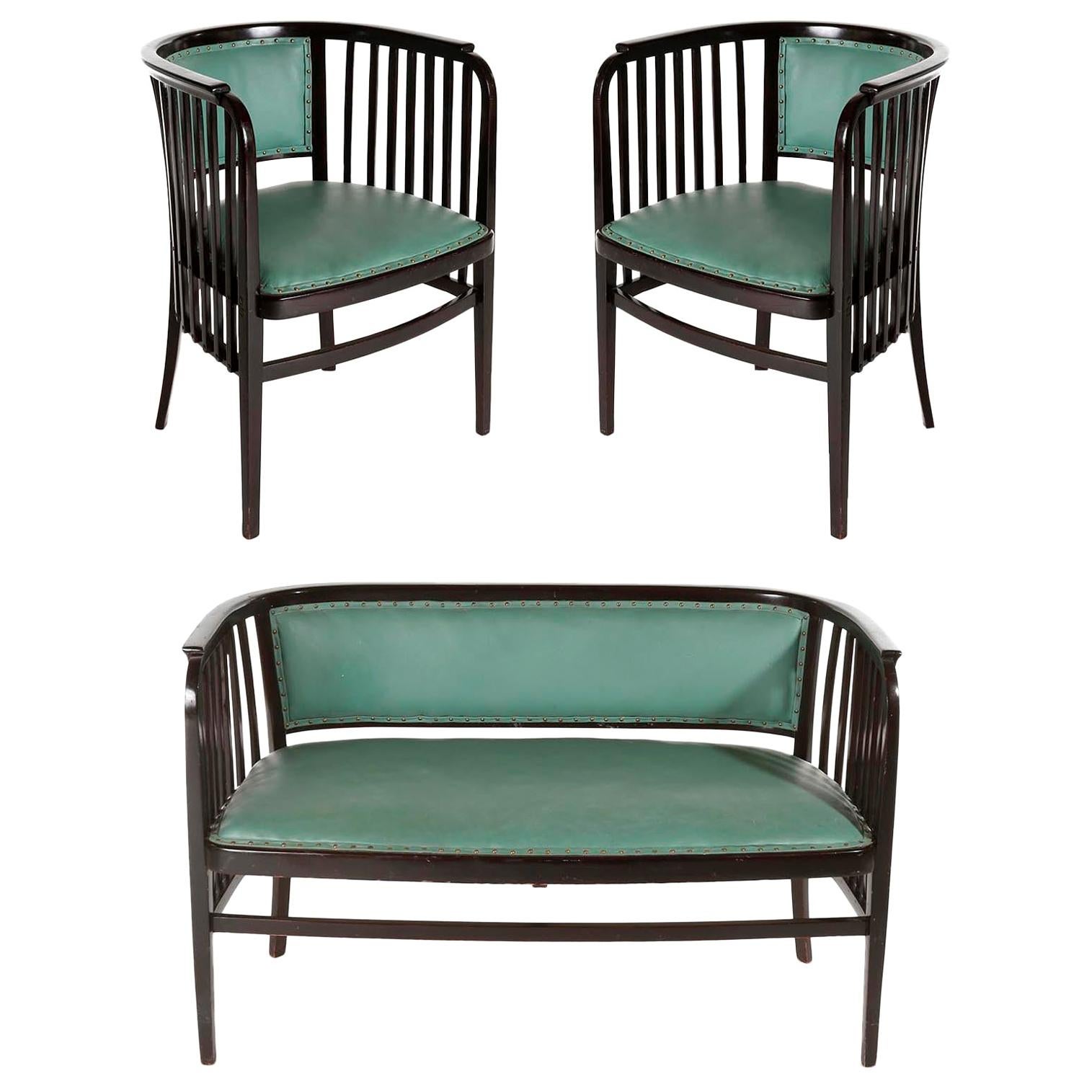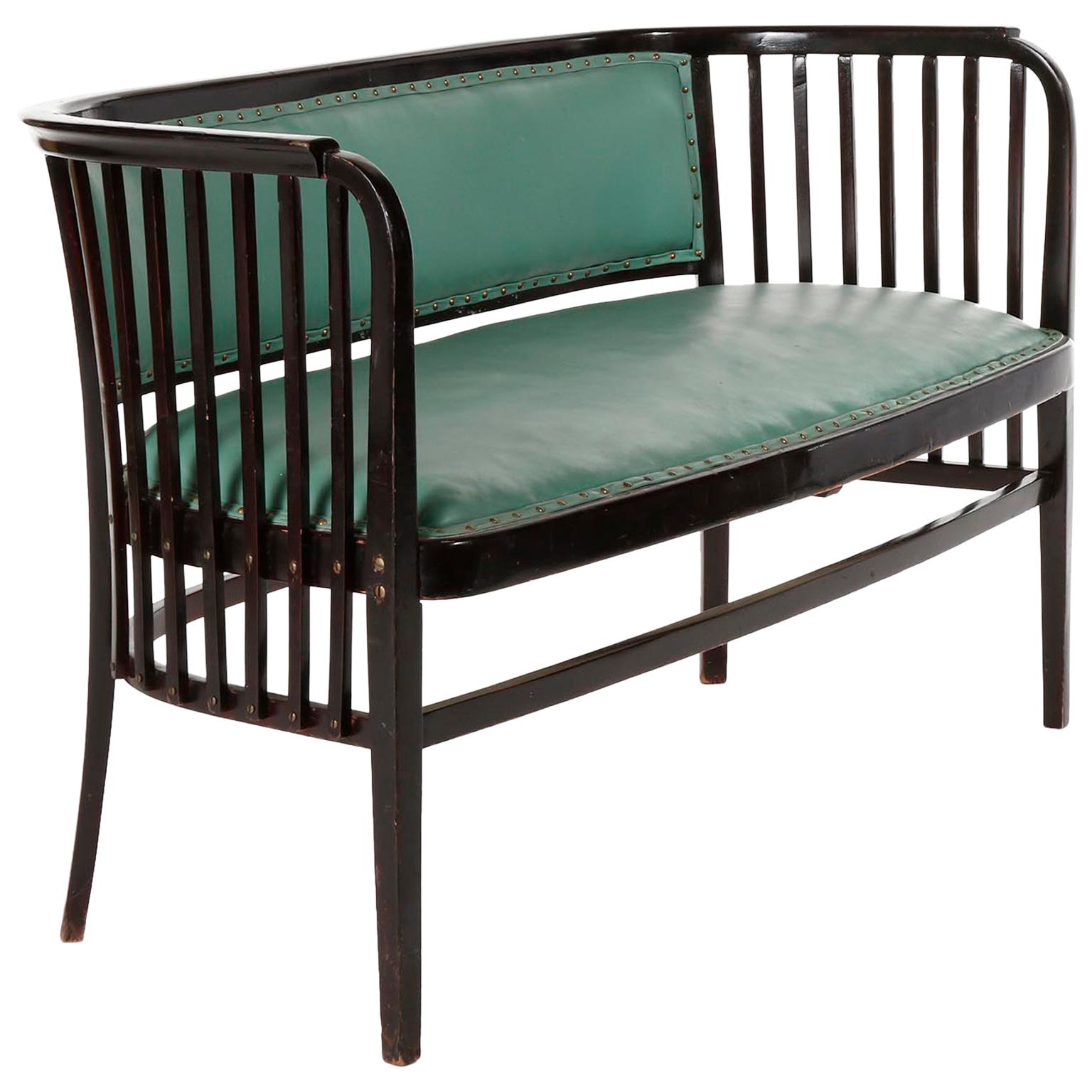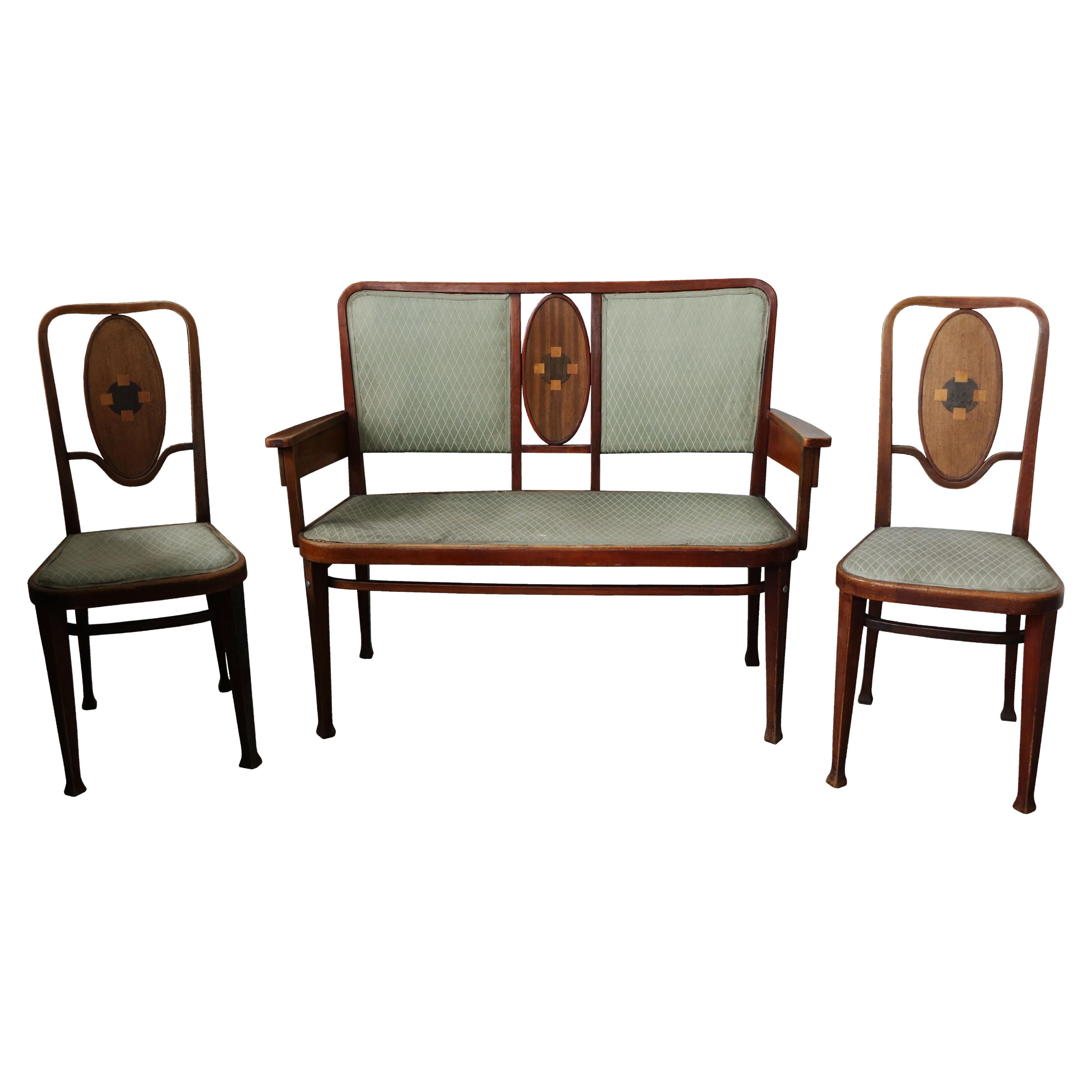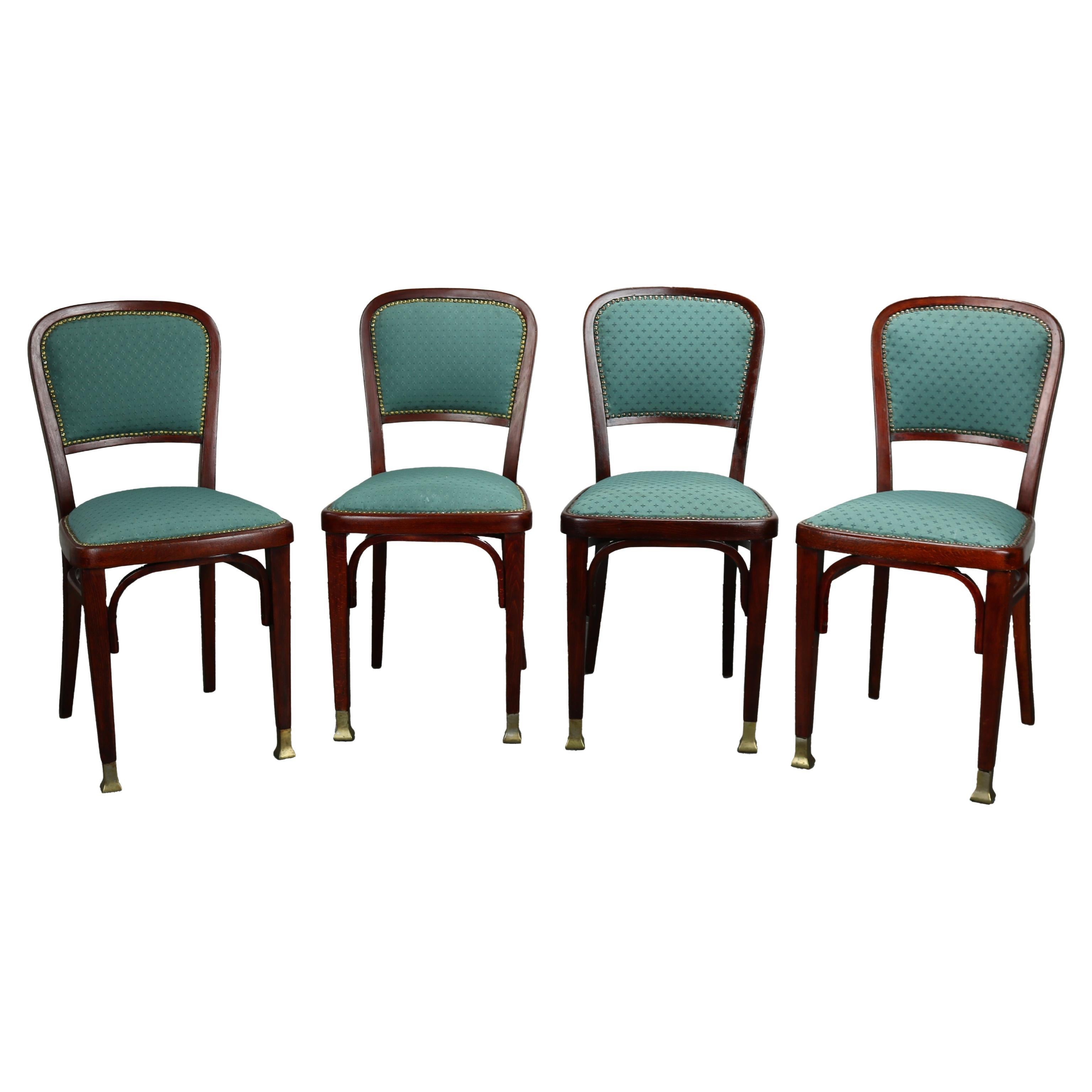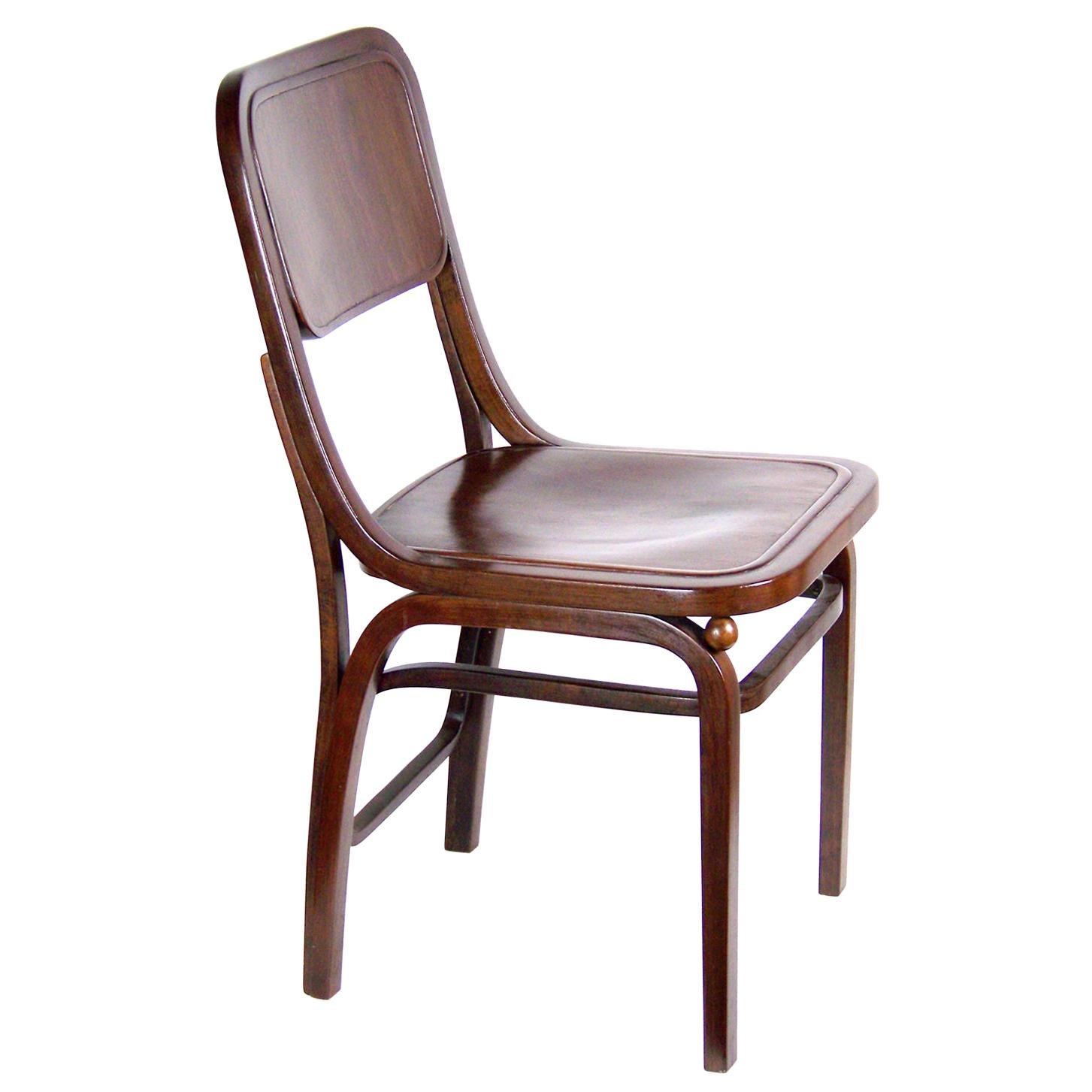Items Similar to Pair of Armchairs Chairs Marcel Kammerer, Thonet, Turquoise Green Leather, 1910
Want more images or videos?
Request additional images or videos from the seller
1 of 20
Pair of Armchairs Chairs Marcel Kammerer, Thonet, Turquoise Green Leather, 1910
About the Item
A pair of fantastic bentwood armchairs designed by Marcel Kammerer and manufactured by Thonet, Austria, circa 1910.
They are made of dark or almost black stained beech wood in mahogany tone and French polished, a technique that involves hand applying many thin coats of shellac which was used for high quality pieces in that time.
The seats and backs are upholstered in a green or turquoise leather. Nice brass screws and nails are in contrast to the dark wood and green leather.
The chairs are in very good condition and have been restored about 10 years ago.
There is also a matching seette or bench available. The whole set is offered in separate listing.
About Marcel Kammerer:
Marcel Kammerer (born 11/4/1878 in Vienna, died 12/25/1959 in Montreal) was an Austrian architect and painter. He was pupil of Otto Wagner and worked several years as chef designer for his studio were he worked for many important projects like the 'Kirche am Steinhof'. Marcel Kammerer designed most of the furniture for the 'Postsparcassen-Amt' which was one of the most important projects from Otto Wagner.
Later Marcel Kammerer establishd his own studio.
His work also was influenced by Josef Hoffmann which was one of the most important Austrian architects.
Between the world wars Marcel Kammerer primary worked was as painter. After 1945 he emigrated to Canada.
Otto Wagner was born in Penzing, a district in Vienna. He was the son of Suzanne (née von Helffenstorffer-Hueber) and Rudolf Simeon Wagner, a notary to the Royal Hungarian Court. He studied architecture at the Viennese Polytechnic Institute and the Royal School of Architecture in Berlin. After completing his education, he returned to Vienna to work. In 1864, he started designing his first buildings in the historicist style. In the mid- and late 1880s, like many of his contemporaries in Germany (such as Constantin Lipsius, Richard Streiter and Georg Heuser), Switzerland (Hans Auer and Alfred Friedrich Bluntschli) and France (Paul Sédille), Wagner became a proponent of Architectural Realism. It was a theoretical position that enabled him to mitigate the reliance on historical forms. In 1894, when he became Professor of Architecture at the Academy of Fine Arts Vienna, he was well advanced on his path toward a more radical opposition to the prevailing currents of historicist architecture.
By mid-1890s, he had already designed several Jugendstil buildings. Wagner was very interested in urban planning — in 1890 he designed a new city plan for Vienna, but only his urban rail network, the Stadtbahn, was
built. In 1896 he published a textbook entitled Modern Architecture in which he expressed his ideas about the role of the architect; it was based on the text of his 1894 inaugural lecture to the Academy. His style incorporated the use of new materials and new forms to reflect the fact that society itself was changing. In his textbook, he stated that "new human tasks and views called for a change or reconstitution of existing forms". In pursuit of this ideal, he designed and built structures that reflected their intended function, such as the austere Neustiftgasse apartment block in Vienna.
In 1897, he joined Gustav Klimt, Joseph Maria Olbrich, Josef Hoffmann and Koloman Moser shortly after they founded the "Vienna Secession" artistic group. From the ideas of this group he developed a style that included quasi-symbolic references to the new forms of modernity.
The Vienna Secession's work is often referred to (during the years before World War I) as the Austrian version of Jugendstil, the German term for Art Nouveau.
Wagner had a strong influence on his pupils at the Academy of Fine Arts in Vienna. This "Wagner School" included Josef Hoffmann, Joseph Maria Olbrich, Karl Ehn, Jože Plecnik and Max Fabiani. Another student of Wagner's was Rudolph Schindler, who said "Modern Architecture began with Mackintosh in Scotland, Otto Wagner in Vienna, and Louis Sullivan in Chicago." Wagner died in Vienna in 1918.
- Creator:Thonet (Maker),Marcel Kammerer (Designer)
- Dimensions:Height: 30.71 in (78 cm)Width: 22.05 in (56 cm)Depth: 23.63 in (60 cm)Seat Height: 18.9 in (48 cm)
- Sold As:Set of 2
- Style:Jugendstil (Of the Period)
- Materials and Techniques:
- Place of Origin:
- Period:1900-1909
- Date of Manufacture:1910
- Condition:Refinished. Reupholstered. Wear consistent with age and use. The chairs are in very good condition and have been restored about 10 years ago.
- Seller Location:Hausmannstätten, AT
- Reference Number:1stDibs: LU1082414596851
About the Seller
5.0
Platinum Seller
These expertly vetted sellers are 1stDibs' most experienced sellers and are rated highest by our customers.
Established in 2014
1stDibs seller since 2014
1,083 sales on 1stDibs
Typical response time: 1 hour
- ShippingRetrieving quote...Ships From: Nestelbach im Ilztal, Austria
- Return PolicyA return for this item may be initiated within 7 days of delivery.
More From This SellerView All
- Marcel Kammerer Seating Set Salon Suite, Thonet, Turquoise Green Leather, 1910By Josef Hoffmann, Marcel Kammerer, ThonetLocated in Hausmannstätten, ATA fantastic bentwood set seating group designed by Marcel Kammerer and manufactured by Thonet, Austria, circa 1910. The set contains of two armchairs and ...Category
Antique Early 1900s Austrian Art Nouveau Living Room Sets
MaterialsBrass
- Marcel Kammerer Settee Bench Seat, Thonet Austria, Turquoise Green Leather, 1910By Josef Hoffmann, Marcel Kammerer, ThonetLocated in Hausmannstätten, ATA fantastic settee designed by Marcel Kammerer and manufactured by Thonet, Austria, circa 1910. It is made of dark or almost black stained beech wood in mahogany tone and French pol...Category
Antique Early 1900s Austrian Vienna Secession Living Room Sets
MaterialsLeather, Bentwood, Beech
- Pair of Lounge Chairs, Black Leather Chrome, Attributed to Thonet, 1970By ThonetLocated in Hausmannstätten, ATA set of two leather and chrome or nickel lounge chairs attributed to Thonet, Austria, circa 1970 (late 1960s or early 1970s). They are made of a high quality and thick black leather...Category
Vintage 1970s Austrian Mid-Century Modern Lounge Chairs
MaterialsMetal, Chrome
- Pair of Stacking Chairs by Karl Schwanzer, Thonet, Austria, 1950sBy Karl Schwanzer, ThonetLocated in Hausmannstätten, ATA rare set of two Viennese stacking chairs made of brown stained wood designed by Austrian architect Prof. Karl Schwanzer and manufactured by Thonet in the 1950s. This chair was des...Category
Vintage 1950s Austrian Mid-Century Modern Chairs
MaterialsBeech
- Bench Seette Seat by Thonet, Attributed to Josef Frank, Wood, 1940By Josef Frank, ThonetLocated in Hausmannstätten, ATA freestanding 3-seat manufactured by Thonet, Austria, in late 1930s or early 1940s. The design is attributed to Josef Frank. This comfortable and handmade seette is made of warm ton...Category
Vintage 1940s Austrian Mid-Century Modern Living Room Sets
MaterialsFabric, Wood
- Pair of Josef Frank Armchairs A 752, Wood Cane, Thonet, Austria, 1930sBy Josef Frank, Gebrüder Thonet Vienna GmbHLocated in Hausmannstätten, ATA set of two chairs model 'Kaminfauteuil A 752' (engl. fireplace armchair) designed by Josef Frank and manufactured by Thonet, Vienna, Austria, circ...Category
Vintage 1930s Austrian Art Deco Armchairs
MaterialsBeech, Cane
You May Also Like
- 1900s Marcel Kammerer Chair No.6517 for Thonet, AustriaBy Thonet, Marcel KammererLocated in Praha, CZ- newly upholstered in Backhausen fabric - carefully refurbished and finished with ebony shellac - Height of seat 47 cm.Category
Antique Early 1900s Austrian Art Nouveau Chairs
MaterialsFabric, Wood
- 20th Century Fine Set of Thonet Art Nouveau by Marcel Kammerer. Vienna, C. 1910.By Marcel KammererLocated in Vienna, ATHello, We would like to offer you a beautiful set designed by Marcel Kammerer and manufactured by Thonet in Vienna, c. 1910. The set consists of two chairs and a settee. The pieces were made by the best craftsmen with the use of the finest quality material. Marcel Kammerer designs are characterized by sublime proportions and high quality manufacturing. These high quality set is very rare and difficult to find. The pieces will be a great complement to any elegant interior. It does not matter whether it is a classic or modern interior because Art Nouveau is simply timeless. Viennese Thonet is distinguished by their sophisticated proportions, rare and refined design and excellent craftsmanship and continue to have a great influence on modern design. Marcel Kammerer (1878 Vienna--1959 Montreal) was a successful Viennese architect and designer, as well as a painter. He studied at the Staatsgewerbeschule (State Trade School) in Vienna and then at the "Wagnerschule” (Wagner School). From 1902 to 1910, Kammerer worked in Otto Wagner’s studio, where he became chief draughtsman and participated in major projects such as the Post Office Savings Bank and the Steinhof Church...Category
Early 20th Century Austrian Art Nouveau Living Room Sets
MaterialsUpholstery, Beech, Walnut
- Set of four chairs by Marcel Kammerer for Thonet, circa 1910By Gebrüder Thonet Vienna GmbH, Marcel KammererLocated in Lučenec, SKOne of the creations of designer Marcel Kammerer, manufactured by Gebruder Thonet in Vienna, part of Thonet salon suite Thonet no 6517. This classic desig...Category
Vintage 1910s Austrian Vienna Secession Chairs
MaterialsBrass
- Chair Thonet Nr. 404, Marcel Kammerer in 1905By Gebrüder Thonet Vienna GmbH, Marcel KammererLocated in Praha, CZExtremely rare chair Thonet Nr. 404. Probably designed for the wine bar of the Municipal House in Prague in 1910 by a minor modification of a chair designed by Marcel Kammerer possib...Category
Early 20th Century Austrian Art Nouveau Chairs
MaterialsBentwood
- Secessionistic Armchair by Marcel Kammerer for Thonet Brothers (Vienna, 1910)By Thonet, Marcel KammererLocated in Wien, ATObjekt: Armlehnstuhl (4 Stück) Entwurf: Marcel Kammerer (Schule Otto Wagner) zugeschrieben, Wien um 1902 Modell-Nummer: 6517 Ausführung: Gebrüder Thonet, Wien um 1910 Maße in cm (H x...Category
Vintage 1910s Austrian Vienna Secession Armchairs
MaterialsBeech, Bentwood, Fabric
- Thonet Bentwood Seating Set/ Salon Suite by M. Kammerer, Austria, circa 1910By Gebrüder Thonet Vienna GmbH, Marcel KammererLocated in Lichtenberg, ATTimeless Thonet bentwood seating set or Salon Suite designed by famous austrian architect and painter Marcel Kammerer in the beginning of the 20th century around 1910. M. Kammerer was a master of form language which reflects best in this absolute fantastic shaped bentwood furniture. Fitting to almost any kind of interior design, weather it is contemporary or residential, this Thonet seating set includes a wonderful bench and two fantastic armchairs, all newly upholstered in fine green alcantara during the restoration process. An absolute outstanding Art Nouveau salon suite...Category
Early 20th Century Austrian Art Nouveau Living Room Sets
MaterialsFabric, Bentwood
Recently Viewed
View AllMore Ways To Browse
Green Set
Chairs For Living Room Upholstered
Pair Of Living Room Chairs Leather
Green Leather Furniture
High Back Living Room Chair
Turquoise Set
Matching Living Room Chairs
Antique Style Living Room Sets
Antique Style Living Room Set
Louis Seating Set
Antique Green Leather
Vienna Set
Green Leather Wood
Thonet Austria
Seat Green Leather
Bentwood Set
Set Of Bentwood
Scottish Set
